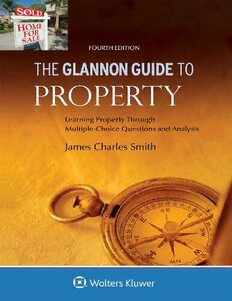
The Glannon Guide to Property PDF
Preview The Glannon Guide to Property
The Glannon Guide to Property EDITORIAL ADVISORS Rachel E. Barkow Segal Family Professor of Regulatory Law and Policy Faculty Director, Center on the Administration of Criminal Law New York University School of Law Erwin Chemerinsky Dean and Jesse H. Choper Distinguished Professor of Law University of California, Berkeley School of Law Richard A. Epstein Laurence A. Tisch Professor of Law New York University School of Law Peter and Kirsten Bedford Senior Fellow The Hoover Institution Senior Lecturer in Law The University of Chicago Ronald J. Gilson Charles J. Meyers Professor of Law and Business Stanford University Marc and Eva Stern Professor of Law and Business Columbia Law School James E. Krier Earl Warren DeLano Professor of Law The University of Michigan Law School Tracey L. Meares Walton Hale Hamilton Professor of Law Director, The Justice Collaboratory Yale Law School Richard K. Neumann, Jr. Alexander Bickel Professor of Law Maurice A. Deane School of Law at Hofstra University Robert H. Sitkoff John L. Gray Professor of Law Harvard Law School David Alan Sklansky Stanley Morrison Professor of Law Faculty Co-Director, Stanford Criminal Justice Center Stanford Law School The Glannon Guide to Property Learning Property Through Multiple-Choice Questions and Analysis Fourth Edition James Charles Smith John Byrd Martin Chair of Law Emeritus University of Georgia Copyright © 2019 CCH Incorporated. Published by Wolters Kluwer in New York. Wolters Kluwer Legal & Regulatory U.S. serves customers worldwide with CCH, Aspen Publishers, and Kluwer Law International products. (www.WKLegaledu.com) No part of this publication may be reproduced or transmitted in any form or by any means, electronic or mechanical, including photocopy, recording, or utilized by any information storage or retrieval system, without written permission from the publisher. For information about permissions or to request permissions online, visit us at www.WKLegaledu.com, or a written request may be faxed to our permissions department at 212-771-0803. To contact Customer Service, e-mail [email protected], call 1-800-234-1660, fax 1- 800-901-9075, or mail correspondence to: Wolters Kluwer Law & Business Attn: Order Department PO Box 990 Frederick, MD 21705 Library of Congress Cataloging-in-Publication Data Names: Smith, James Charles, 1952- author. Title: The Glannon guide to property : learning property through multiple-choice questions and analysis / James Charles Smith, John Byrd Martin Chair of Law, University of Georgia. Description: Fourth edition. | New York : Wolters Kluwer, [2018]. Identifiers: LCCN 2018033181 | eISBN: 978-1-5438-0297-9 Subjects: LCSH: Property — United States — Problems, exercises, etc. | Real property — United States — Problems, exercises, etc. Classification: LCC KF561 .S627 2018 | DDC 346.7304076 — dc23 LC record available at https://lccn.loc.gov/2018033181 About Wolters Kluwer Legal & Regulatory U.S. Wolters Kluwer Legal & Regulatory U.S. delivers expert content and solutions in the areas of law, corporate compliance, health compliance, reimbursement, and legal education. Its practical solutions help customers successfully navigate the demands of a changing environment to drive their daily activities, enhance decision quality and inspire confident outcomes. Serving customers worldwide, its legal and regulatory portfolio includes products under the Aspen Publishers, CCH Incorporated, Kluwer Law International, ftwilliam.com and MediRegs names. They are regarded as exceptional and trusted resources for general legal and practice-specific knowledge, compliance and risk management, dynamic workflow solutions, and expert commentary. I dedicate this book to my children, Nicole and Kristin, in recognition of all that they have taught me. Contents Acknowledgments Chapter 1: A Very Short Introduction Chapter 2: Finders of Personal Property A. The General Rule B. The Public/Private Place Distinction C. Mislaid Property D. Abandoned Property E. Treasure Trove F. The Closer: Other Factors Chapter 3: Bailments A. The Nature of Bailments B. Whom Does the Bailment Benefit? C. The Bailee’s Standard of Care D. The Closer: Divisible Bailments — The Problem of Contents Chapter 4: Gifts of Personal Property A. The Basic Elements B. Physical Delivery C. Constructive and Symbolic Deliveries D. Acceptance E. Gift Causa Mortis F. The Closer: Gifts of Future Interests Chapter 5: Intellectual Property A. Patents B. Copyrights C. Trademarks D. Trade Secrets E. Misappropriation F. Right of Publicity G. The Closer: Distinguishing among the IP Categories Chapter 6: Adverse Possession of Real Property A. The Basic Concept: Wrongful Possession B. Standard Elements and Policies C. Adverse Possession and Record Title D. Color of Title and Constructive Adverse Possession E. Open and Notorious Possession F. Hostile and Adverse Possession G. Exclusive Possession H. Continuous Possession and Tacking I. Disability Provisions J. The Closer: State of Mind Chapter 7: Adverse Possession of Personal Property A. Adverse Possession Elements B. Discovery Rule C. Demand and Refusal Rule D. The Closer: True Owner Obtains Possession Extrajudicially Chapter 8: Fee Simple Estates A. Some Basic Principles B. Creation of Fee Simple at Common Law: Words of Inheritance C. Creation under Modern Statutes: Presumption of Fee Simple D. Rebutting the Presumption of Fee Simple E. The Closer: Dying without Heirs Chapter 9: Defeasible Estates A. The Nature of Defeasible Estates B. What Language Makes an Estate Defeasible? C. The Fee Simple Determinable D. The Fee Simple Subject to Condition Subsequent E. The Fee Simple Subject to Executory Limitation F. The Closer: Distinguishing Cutting Short an Estate and the Natural Expiration of an Estate Chapter 10: Life Estates A. The Nature of the Life Estate B. Legal and Equitable Life Estates C. The Doctrine of Waste D. The Closer: Continuing an Ongoing Activity Chapter 11: Reversions and Remainders A. Distinguishing Reversions and Remainders B. Types of Remainders C. Distinction between the Contingent Remainder and the Vested Remainder Subject to Complete Divestment D. Alternative Contingent Remainders E. The Closer: Stripping the Share of a Deceased Grantee Chapter 12: Executory Interests A. The History of Executory Interests B. Active Trusts C. Distinction between Springing and Shifting Executory Interests D. The Divesting Effect of Executory Interests E. The Closer: Taking Away a Trust Beneficiary’s Interest Chapter 13: Rule against Perpetuities
